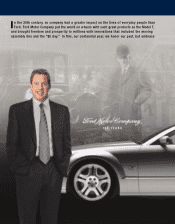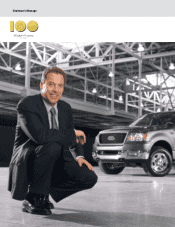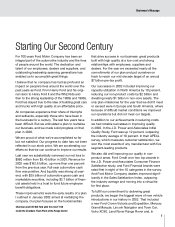Ford 2002 Annual Report Download - page 12
Download and view the complete annual report
Please find page 12 of the 2002 Ford annual report below. You can navigate through the pages in the report by either clicking on the pages listed below, or by using the keyword search tool below to find specific information within the annual report.
imagine it.
Today, creating a new car or truck is a company-wide endeavor.
It involves everyone from the designers in the studios, to the customers
who inspire them, the suppliers who produce components, to the
people who will assemble the vehicle in the plant, and the dealers
who will sell them.
Everything begins with customers. We ask questions ... Who are they?
How do they see themselves? What are their preferences — not only
in terms of vehicles and services, but in terms of lifestyles, fashion,
entertainment and culture? That’s why you’ll see Ford marketing people
at auto shows, as well as amusement parks, boat shows and other
lifestyle activities.
We study the connection customers have with each of our brands
and determine those elements that make each brand unique and
distinctive. Then we create a vehicle that honors that legacy in new
and exciting ways.
We also understand that customers expect value. So, high-quality
components that the customer does not see, hear, touch or smell—
things such as switch mechanisms, wiper motors, or blowers —
can be commonized across many vehicles. This allows us to act
economically by buying in quantity.
It’s a living, breathing way of making new cars and trucks. And it starts
exactly as Henry Ford started 100 years ago — with imagination and a
better idea.
At Volvo Car Corporation’s Design Studios in
Gothenburg, Sweden, Robin Lock, senior designer
(center), and José Diaz de la Vega, creative director,
strategic design (right), review a clay model of the
Versatility Concept car, as Carl Ringquist, designer,
completes vehicle details at the drawing table.
10
Volvo Versatility Concept Car
$5 WORKDAY
Henry Ford
announces
that the
company’s
minimum
wage would
be $5 a day —
more than double the existing rate.
1914
MODEL T
The 1914
model is
the first to
be built on
Henry Ford’s
moving assembly line. Eventually, a new
Model T rolls off the line every ten seconds
of every working day.
1917
MODEL TT
Moving and transporting goods
becomes easier with the Model TT,
the first Ford truck.
1918
ROUGE COMPLEX
GROUNDBREAKING
Construction begins on
the massive automotive
manufacturing complex,
allowing for the
complete production
of vehicles from raw
materials processing
to final assembly.
























